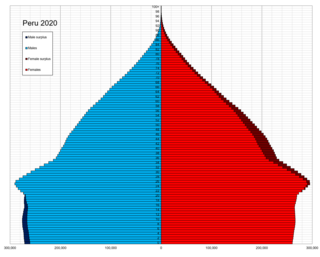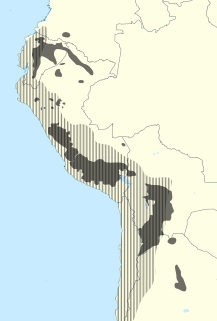Related Research Articles

The Inca Empire, also known as Incan Empire and the Inka Empire, and at the time known as the Realm of the Four Parts, was the largest empire in pre-Columbian America. The administrative, political and military center of the empire was in the city of Cusco. The Inca civilization arose from the Peruvian highlands sometime in the early 13th century. The Spanish began the conquest of the Inca Empire in 1532 and its last stronghold was conquered in 1572.

This article is about the demographic features of the population of Peru, including population density, ethnicity, education level, the health of the populace, economic status, religious affiliations and other aspects of the population.

Quechua, usually called Runasimi in Quechuan languages, is an indigenous language family spoken by the Quechua peoples, primarily living in the Peruvian Andes. Derived from a common ancestral language, it is the most widely spoken pre-Columbian language family of the Americas, with an estimated 8–10 million speakers as of 2004. Approximately 25% of Peruvians speak a Quechuan language. It is perhaps most widely known for being the main language family of the Inca Empire. The Spaniards encouraged its use until the Peruvian struggle for independence of the 1780s. As a result, Quechua variants are still widely spoken today, being the co-official language of many regions and the second most spoken language family in Peru.

South America is a continent entirely in the Western Hemisphere and mostly in the Southern Hemisphere, with a relatively small portion in the Northern Hemisphere. It can also be described as the southern subregion of a single continent called America. The reference to South America instead of other cultural or geographical regions has increased in recent decades due to changing geopolitical dynamics.

Peru, officially the Republic of Peru, is a country in western South America. It is bordered in the north by Ecuador and Colombia, in the east by Brazil, in the southeast by Bolivia, in the south by Chile, and in the south and west by the Pacific Ocean. Peru is a megadiverse country with habitats ranging from the arid plains of the Pacific coastal region in the west to the peaks of the Andes mountains extending from the north to the southeast of the country to the tropical Amazon Basin rainforest in the east with the Amazon river. Peru has a population of 34 million, and its capital and largest city is Lima. At 1.28 million km2, Peru is the 19th largest country in the world, and the third largest in South America.

Aymara is an Aymaran language spoken by the Aymara people of the Bolivian Andes. It is one of only a handful of Native American languages with over one million speakers. Aymara, along with Spanish, is an official language in Bolivia and Peru. It is also spoken, to a much lesser extent, by some communities in northern Chile, where it is a recognized minority language.

Ayacucho is a department and region of Peru, located in the south-central Andes of the country. Its capital is the city of Ayacucho. The region was one of the hardest hit in the 1980s during the guerrilla war waged by Shining Path known as the internal conflict in Peru.

Cuzco, also spelled Cusco, is a department and region in Peru and is the fourth largest department in the country, after Madre de Dios, Ucayali, and Loreto. It borders the departments of Ucayali on the north; Madre de Dios and Puno on the east; Arequipa on the south; and Apurímac, Ayacucho and Junín on the west. Its capital is Cusco, the historical capital of the Inca Empire.
Latin Americans are the citizens of Latin American countries. Latin American countries and their diasporas are multi-ethnic and multi-racial. Latin Americans are a pan-ethnicity consisting of people of different ethnic and national backgrounds. As a result, some Latin Americans do not take their nationality as an ethnicity, but identify themselves with a combination of their nationality, ethnicity and their ancestral origins. Aside from the Indigenous Amerindian population, all Latin Americans have some Old World ancestors who arrived since 1492. Latin America has the largest diasporas of Spaniards, Portuguese, black Africans, Italians, Lebanese and Japanese in the world. The region also has large German, French, Palestinian, Chinese and Jewish diasporas.

Quechua people or Quecha people, may refer to any of the aboriginal people of South America who speak the Quechua languages, which originated among the Indigenous people of Peru. Although most Quechua speakers are native to Peru, there are some significant populations in Ecuador, Bolivia, Chile, Colombia, and Argentina.
Peru has many languages in use. One of its official languages, Spanish, has been in the country since it began being taught in the time of José Pardo instead of the country's Native languages, especially the languages in the Andes. In the beginning of the 21st century, it was estimated that in this multilingual country, about 50 very different and popular language's are spoken: there are 72 languages if dialects are considered. The majority of these languages are Indigenous, but the most common language is Spanish, the main language that about 82.6% of the population speaks. Spanish is followed by the country's Indigenous languages, especially all types of Quechua and Aymara (1.7%), who also have co-official status according to Article 48 of the Constitution of Peru, as well as the languages of the Amazon and the Peruvian Sign Language. In urban areas of the country, especially the coastal region, most people are monolingual and only speak Spanish, while in many rural areas of the country, especially in the Amazon, multilingual populations are prevalent.

Pano-Tacanan is a proposed family of languages spoken in Peru, western Brazil, Bolivia and northern Paraguay. There are two close-knit branches, Panoan and Tacanan, with 33 languages. There are lexical and grammatical similarities between the two branches, but it has not yet been demonstrated that these are genetic.
The present-day Department of Amazonas in Peru, occupying part of the western Amazon basin, carries evidence of human cultures predating the Inca Empire. The presence of the Chachapoya culture and the Wari culture in architectural excavations allow for evidence of multiple civilized presences previous to the conquest of the area by the Incan Empire.

Peruvians are the citizens of Peru. There were Andean and coastal ancient civilizations like Caral, which inhabited what is now Peruvian territory for several millennia before the Spanish conquest in the 16th century; Peruvian population decreased from an estimated 5–9 million in the 1520s to around 600,000 in 1620 mainly because of infectious diseases. Spaniards and Africans arrived in large numbers in 1532 under colonial rule, mixing widely with each other and with Native Peruvians. During the Republic, there has been a gradual immigration of European people. Chinese and Japanese arrived in large numbers at the end of the 19th century.
Cocama (Kokáma) is a language spoken by thousands of people in western South America. It is spoken along the banks of the Northeastern lower Ucayali, lower Marañón, and Huallaga rivers and in neighboring areas of Brazil and an isolated area in Colombia. There are three dialects. The robust dialect is known as Cocama, Kokama, Kukama-Kukamiria, Ucayali, Xibitaoan, Huallaga, Pampadeque, and Pandequebo. By 1999, Cocamilla (Kokamíya) was moribund, being only spoken by people over 40.
Education in Peru is under the jurisdiction of the Ministry of Education, which oversees formulating, implementing and supervising the national educational policy. According to the Constitution of Peru, education is compulsory and free in public schools for the initial, primary and secondary levels. It is also free in public universities for students who are unable to pay tuition and have an adequate academic performance.

The following outline is provided as an overview of and topical guide to South America.
Peruvian Sign Language (LSP) by its acronym in Spanish: "lengua de señas peruana") ) is a Peruvian language created and used by the Deaf community in Peru. It has been officially recognized by Peruvian law since 2010. It is not clear how many users there are in the country; the most recent general census registered little more than 10,000, but the more specific census on people with special needs found around half a million people with hearing disabilities.
References
- ↑ Urban, Matthias. 2019. Lost languages of the Peruvian North Coast . Estudios Indiana 12. Berlin: Ibero-Amerikanisches Institut (Preußischer Kulturbesitz) & Gebr. Mann Verlag.